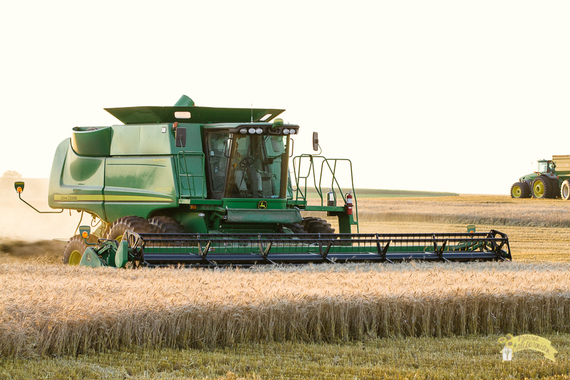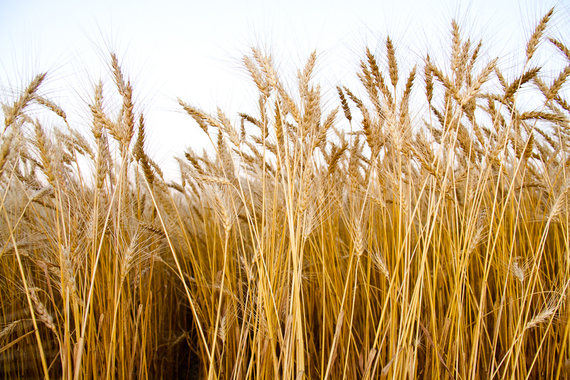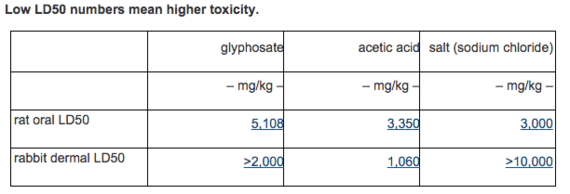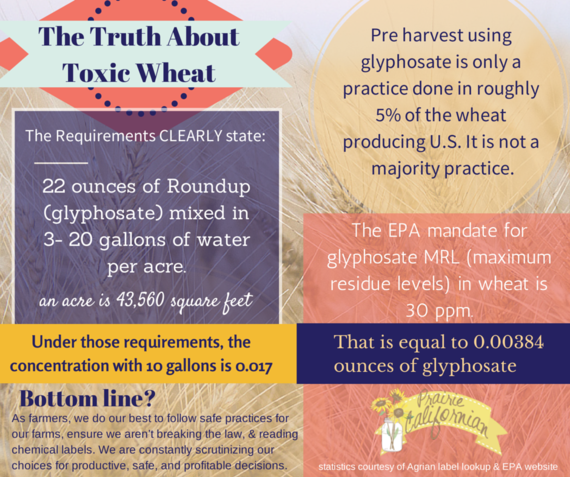You may or may not have seen this article from the Healthy Home Economist touting wheat is toxic due to being sprayed with Round up (glyphosate) as a pre-harvest. This article brings up some pretty fear inducing statistics for both farmers and non-farmers. Farming is our life and our passion and when someone spreads fear in regards to our livelihood, it is hard not to take it personal. So we respond in the best way we know how, through our own experiences and how we run our own farms.
Unfortunately, trying to lump all farming practices in one category doesn't help the credibility we are trying to establish as farmers. Here's the problem. Farming is not black and white, farming is not one size fits all, and there are no absolutes in farming. Farming can vary greatly depending on region, soil, climate, crop variety, etc. And this particular article proves that point well.
The problem lies in when we try and make blanket statements about all wheat production. For each different variety of wheat whether it be durum wheat, hard red spring wheat, or even soft red winter wheat, there are different production methods for each one. But here's what is the same on every farm... As farmers, we do our best to follow safe practices for our farms, ensure we aren't breaking the law, reading chemical labels. We are constantly scrutinizing our choices for productive, safe, and profitable decisions. And let me tell you, it isn't an easy process.
If you've read my posts before, you know I strive for truth and honesty. There is nothing in our production methods I want to hide from you all. So I want to address some of the myths that have been circulating about pre-harvest of hard red spring wheat since it is a practice we do on our farm and have done for years.
It is not a practice that is widespread across the United States.
Pre-harvesting wheat with glyphosate (most commonly Roundup) is not something the majority of wheat farmers across the nation do. There is a small sector and region of wheat production that practices this: mainly North Dakota, small parts of South Dakota, and parts of Canada. In the United States, North Dakota represents about 5% of total wheat acres produced. We are, however, the second hard red spring wheat producer in the nation. So the claim that this occurs everywhere is not at all valid or true since only about 5% of the total production practices this pre-harvesting.
Wheat farmers in Kansas, Oklahoma, and the majority of the wheat belt producing regions don't have a need to pre-harvest wheat for a number of reasons ranging from their typically dry and warm climate to the variety of wheat they grow.
So Why Do We Pre-harvest our Wheat?
Wheat has been grown on our farm since the first generation with my husband's grandfather. Historically on our farm, we would swath our wheat while it was not fully mature. Basically cut it and lay it in windrows to let it dry. It would lie there until the kernels reached desired moisture content (anything less than 18%, but ideally around 13.5%). Once it reached desired moisture, it would be picked up out of the rows and harvested much like we do today.
So why don't we continue to do that? There are a number of reasons for this.
First, the advent of pre-harvesting with glyphosate has allowed us to eliminate the swathing step completely. Not having to swath our wheat saves us time, labor, and resources like fuel and trips in and out of the field. By pre-harvesting our wheat with glyphosate, we are able to simply use a combine to harvest it as we do with the rest of our crops. We also don't have to run or maintain two pieces of equipment; the combine does all the work. With swathing there is also a danger of the downed wheat sprouting, any time you lay grain on the ground; there is the chance of a heavy rain causing sprout damage in the windrow.
But on top of not having to maintain or run another piece of equipment, one of the biggest advantages is that pre-harvesting with glyphosate allows very even ripening of the wheat. Glyphosate has been shown to reduce the amount of time that it takes for a crop to reach harvest moisture if conditions are not favorable for drying. Even ripening is important to maintain quality (test weight) in our wheat crop. Some years it is a more viable practice in heavy or lodged wheat (basically wheat that has fallen down) or uneven emergence after planting. We also have the added benefit of an opportunity to control weeds pre-harvest with a glyphosate application.
However, applying this pre-harvest glyphosate too early can reduce yield and test weight. It is also not encouraged to be used in seed wheat or malt barley due to the fact that glyphosate can interfere with the germination process after harvesting. This is the reason the label discussed below clearly states it is for use on feed barley only.
Is Pre-harvesting Wheat with Glyphosate Even Legal or Licensed?
As with any chemical we use on our farm, it has a label that gives us extensive information about how to use the chemical. This label is not simply a suggested use guide; it is indeed a federal and civil regulation under FIFRA (Federal Insecticide, Fungicide, and Rodenticide Act) through the EPA.
All chemicals we use on the farm are required to be registered through the EPA. This registration requires studies to be conducted to establish the conditions in which the chemical is safe to use and that the product does not pose adverse effects to humans or the environment. An applicant will have to prove that the pesticide active ingredient will not cause unreasonable adverse effects on human health and environment. An unreasonable adverse effect is defined as: (1) any risk that is unreasonable to man or the environment that takes social, economic, and environmental costs as well as benefits into consideration and (2) any dietary risk that could be the result of a pesticide. In addition to the EPA regulations required to be met, the USDA and FDA set standards for level of pesticide residue that is allowed on or in crops for that particular chemical.
All registered products must be reviewed every 15 years to ensure they continue to meet the proper standards. During this registration process, a label is created. The label contains directions for proper use, safety restrictions, and much more information. All of these chemical labels can be looked up using a free website such as Agrian or CDMS. FIFRA is enforced through the EPA and requires all users to adhere to the requirements set during the registration process. Breaking of these requirements is against the law. This includes using a pesticide in any manner not consistent with the label.
If you look up the Roundup Powermax label, for example, you will find the manufacturer gives us the requirements and restrictions for Grains and Cereals among many other crops from leafy vegetables, fruits, sugarcane, and legumes. Under section 9.1, Cereals and Grains, the label is very specific what crops can be used with this specific chemical: Barley; Buckwheat; Millet (pearl, proso); Oats; Rice; Rye; Quinoa; Teff; Teosinte; Triticale; Wheat (all types); Wild Rice. Any other cereals or grains are not labeled for this chemical. Under this section as well there are also requirements for Pre-harvest on Feed Barley and Wheat ONLY.
So what are the requirements?
- For wheat, apply after the hard-dough stage when grain moisture is 30 percent or less.
- Apply this product in 10 to 20 gallons of water per acre when using ground application equipment and in 3 to 10 gallons of water per acre when using aerial application equipment.
And what are the restrictions?
- Do not apply more than 22 fluid ounces of this product per acre (43,560 square feet) for pre-harvest application.
- Allow a minimum of 7 days between application and harvest (this is called a PHI or pre harvest interval)
As I stated before, these are not just "suggestions", these are labeled requirements and restrictions that must be followed by law.
Is Pre-harvesting Wheat with Glyphosate Safe?
Concentration
Before I talk a little about toxicity of glyphosate it is important to note the restrictions on the concentrations of glyphosate, specifically, Roundup. On pre harvest applications, you cannot apply more than 22 ounces per acre mixed with 3 - 20 gallons of water (depending on application). Let me put that into perspective. That is the equivalent of a Gatorade bottle (20 ounces) of Roundup mixed with (let's say on average) 10 gallons of water that is used on the size of an entire football field.
Even better of a perspective, let's convert those gallons to ounces... 22 ounces put into 1,280 ounces of water equals a concentration of 0.017 or 1.7%.
So to address the article's claim about wheat being "doused" or "drenched" in glyphosate is hardly even truth and at the least laughable. How is less than 2% concentration for 43,560 square feet (an acre) dousing our fields?
Toxicity
I think it is safe to say, we've established that the amount of glyphosate we are using to pre harvest our wheat is relatively low. So what about the toxicity? Is glyphosate toxic?
This post by Weed Freaks (Salt, Vinegar, and Glyphosate) addresses the toxicity of glyphosate in comparison to things like acetic acid (vinegar) and sodium chloride (salt) in mammalian values. The chart below gives you a good comparison of toxicity values, presented in mg of material per kg of body weight of the test animal. The lower the LD50 value, the less it takes to kill 50% of the population of test animals. Therefore, the lower the LD50, the greater toxicity of the chemical.
It is interesting to note that in both toxicity measures, vinegar is more toxic than glyphosate. And salt is more toxic to rats than glyphosate when exposed orally. Glyphosate is classified under the FIFRA Toxicity Category IV (virtually the least non-toxic category) and on the MSDS label (or Safety Data Sheet) for Roundup is classified as "practically non-toxic". You can find all the toxicity information on the MSDS sheet for any chemical by searching the Agrian or CDMS websites.
Keep in mind that all of this information has to be approved by the EPA as well as USDA and the FDA in order for it to make it on the label and additional safety information. This is not statements simply "made up" by the chemical manufacturers.
Maximum Residue Level
In addition to toxicity values, there is also another measure done by the EPA and this is called a MRL (maximum residue level). A MRL is the maximum concentration for pesticide residues in or on food to ensure the lowest possible consumer exposure.
For glyphosate, the MRL set for wheat is 30 PPM (parts per million). That doesn't mean much to me so I did some digging. What does parts per million mean exactly? Here are some other ways to express it:
1 milligram/kilogram (mg/kg) = 1 ppm
1 milligram/liter (mg/l) = 1 ppm
1 microgram/gram (µg/g) = 1 ppm
0.0001 % = 1 ppm
What if we put that measurement into ounces? How much glyphosate is allowed in wheat crops? 0.00384 ounces. That seems like a minuscule amount of a fairly non-toxic chemical allowed, doesn't it?
Glyphosate has been the subject of numerous toxicity tests as well as researched for carcinogenic properties. Results have been overwhelming negative. The EPA has classified glyphosate as a Group E meaning it shows no evidence of carcinogenicity in humans based on studies of test animals not producing compelling evidence of this. Here are some great studies to check out:
Conclusion
I know Roundup and glyphosate is a hot button topic and the buzz surrounding the dangers around it are numerous. But when you really take the time to digest some of the facts, read the labels, and put it into perspective with other common household items, the toxicity of glyphosate is extremely low. I've written an article before on fear. We don't need to make our lives more complicated by buying into these fears spread much like the article above. And I hope this post has done just that, taken a little bit of the fear out of it all.
In the end, I honestly and personally don't believe that the wheat we grow on our farm is toxic and would not want to be promoting a product I believed was toxic. We enjoy wheat products all the time at our table just as my husband's family has done for years.
And even if you don't believe a word in this post, that is OK! You are entitled to your own opinion as well as your own choice! If you still choose to forgo conventionally raised wheat, there are options out there like certified organic wheat.
Here is what I do ask. I ask that you understand a few things: Pesticides are complex, I think this article proves that. But I believe that having these conversations is important which is why I spend my time writing about such things. In light of that, I expect the conversations and dialogue here to be respectful and intellectual.
Please remember that we are all people, no matter what side of the fence we are on. Whether we are organic farmers, an employee for the "dreaded Monsanto," or a conventional farmer, we are all people. We have families, friends, and people we care are about. We are all passionate about the food we eat and how it ends up on our tables. And we all care about the health and safety of those we love, farmers are no exception.
To read more about our farm or to ask questions, feel free to visit prairiecalifornian.com.
- EPA (2012) Federal Insecticide, Fungicide, and Rodenticide Act
- Hall, E. (2013) Roundup and Gut Bacteria
- Kniss, A. (2014) Salt, Vinegar, and Glyphosate
- Mink PJ, Mandel JS, Lundin JI, Sceurman BK. (2011) Epidemiologic studies of glyphosate and non-cancer health outcomes: a review.
- Monsanto Company. (2011) Roundup Powermax Herbicide Product Label
- Monsanto Company. (2011) Roundup Powermax Herbicide Safety Data Sheet
- National Pesticide Information Center. Glyphosate General Fact Sheet
- National Pesticide Information Center Glyphosate Technical Fact Sheet
- Ransom, J. (2014) Glyphosate as a Pre-Harvest Aid in Small-Grains
- Ryan, C. (2014) The Dose Makes the Poison
- Scott, B. (2014) Long-Term Glyphosate Use Effect on Wheat
- Wiersma, J. Bongard, P. (2014) Pre-harvest management options for wheat
- Williams AL, Watson RE, DeSesso JM. (2012). Developmental and reproductive outcomes in humans and animals after glyphosate exposure: a critical analysis.
- XiaoZhi Lim. (2014) Is glyphosate, used with some GM crops, dangerously toxic to humans?
For some other resources directly from farmers on glyphosate and pre-harvest wheat, check out these posts:
- Frketich, B. (2014) A Farmer's Response to the Real Reason Wheat is Toxic
- Kansas Wheat (2014) The Truth About Herbicides in Wheat
- Rohrich, J. Schultz, S. (2014) Wheat Farmers' Response to Toxic Wheat
- Schuktz, S. (2014) The Truth about Glyphosate and Wheat
- Scott, B. (2014) Long-Term Glyphosate Use Effect on Wheat



